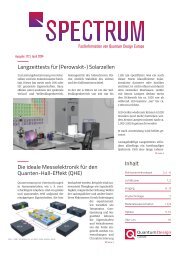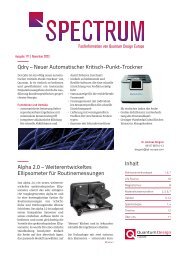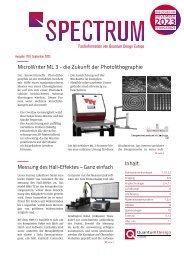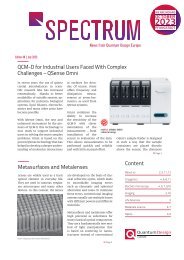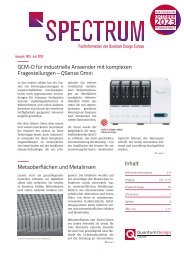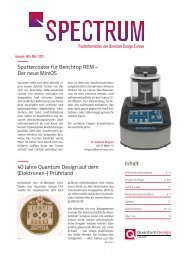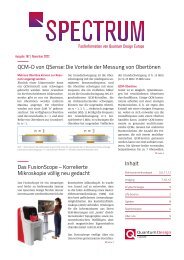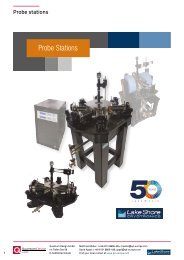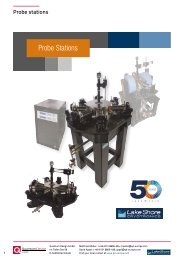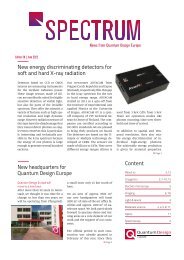Spectrum E39
Create successful ePaper yourself
Turn your PDF publications into a flip-book with our unique Google optimized e-Paper software.
Materials Science<br />
The Lock-In Amplifier – NOT a Closed Book<br />
The lock-in amplifier was developed<br />
in 1941, and has ever since<br />
undisputedly occupied a very<br />
important place when it comes<br />
to sensitive electrical measurements.<br />
But "lock-ins" are also<br />
used in other areas: E.g., in a VSM<br />
magnetometer for sensitive magnetic<br />
measurements such an<br />
amplifier is an essential part of<br />
the measuring electronics.<br />
A lock-in amplifier "equalizes"<br />
frequencies, so, as far as electrical<br />
measurements are concerned, we<br />
always refer to AC applications.<br />
AC means "alternating current",<br />
and an example of what can be<br />
measured is AC resistance. In its<br />
most simple form, the lock-in is<br />
an AC voltmeter that measures<br />
at a fixed frequency only. The signal<br />
from the AC current source<br />
is supplied to the lock-in, passing<br />
through the sample, but it is also<br />
supplied directly as a reference<br />
signal (of course, it would also be<br />
possible to generate the reference<br />
signal internally).<br />
M81<br />
Advantages of the lock-in technology:<br />
The amplitude can be<br />
low, and background noise and<br />
other interfering signals or frequencies<br />
can be removed, since,<br />
in a simplification, we are only<br />
looking at this one frequency. In<br />
the figure, the basic structure of<br />
a lock-in system is shown. The<br />
components highlighted in gray<br />
form part of the DSP (digital signal<br />
processor). The DSP is the heart<br />
of any modern lock-in instrument.<br />
From the figure, it also becomes<br />
clear that in order to really understand<br />
the technology, one has<br />
to have a closer look e.g. at the<br />
function and mode of action of<br />
the various filters. But for those<br />
of our readers who simply want<br />
to make sensitive electrical measurements,<br />
listen: Lake Shore's<br />
M81 measuring system features<br />
an integrated lock-in amplifier<br />
that can easily be activated and<br />
deactivated!<br />
Learn more about the lock-in<br />
technology and gain background<br />
knowledge, including about filters,<br />
noise and different types of<br />
noise, as well as precision and<br />
accuracy, by reading Lake Shore<br />
Cryptotronics' white paper "The<br />
Lock-In Amplifier Explained and<br />
Reimagined", which we will be<br />
happy to send you on request<br />
free of charge, either by e-mail or<br />
as a printout.<br />
For more information, please visit<br />
our website.<br />
www.qd-europe.com<br />
Please contact us<br />
materials@qd-europe.com<br />
A<br />
B<br />
AC or DC<br />
Coupling<br />
A or<br />
A-B<br />
AC gain<br />
Inputfilter<br />
Inputfilter<br />
Outputfilter<br />
X signal<br />
in-phase signal<br />
ext. Input reference<br />
Output Reference<br />
PLL<br />
local<br />
Oscillator<br />
Reference<br />
Phaseshift<br />
Harmonics-<br />
Generator<br />
90° phase<br />
shift<br />
Outputfilter<br />
Y signal<br />
phase shifted signal<br />
quadrature signal<br />
15 <strong>Spectrum</strong>, International edition 39| December 2022




